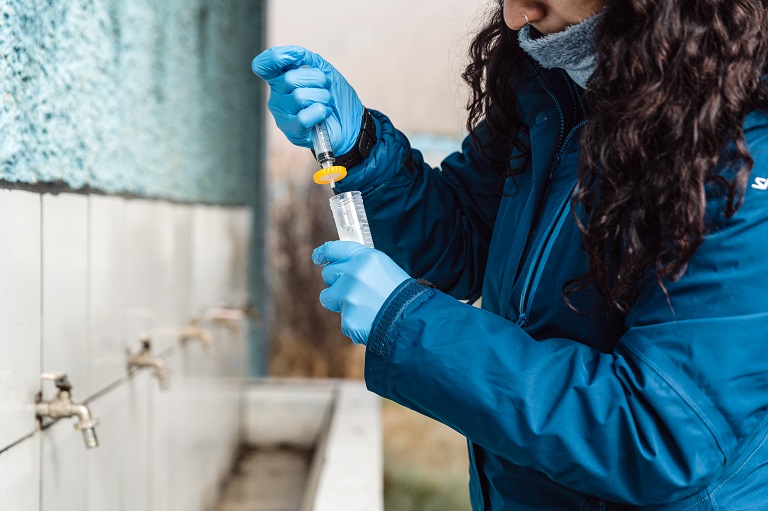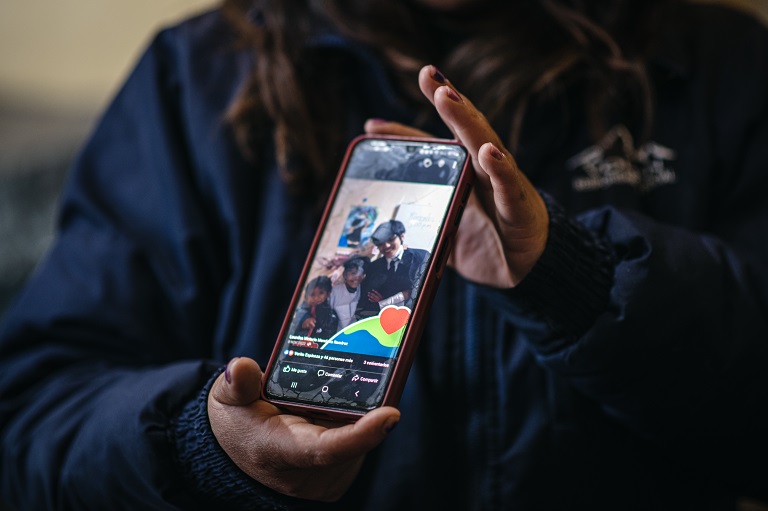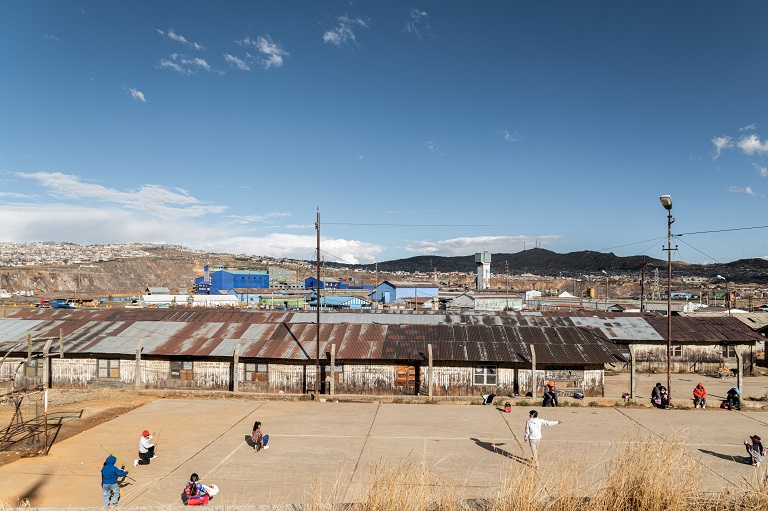- Communities in Cerro de Pasco, Peru, have been living for decades with contamination from mining activities, which has had serious health consequences, ranging from chronic to fatal diseases.
- Repeated environmental samplings have shown that heavy metal levels surpass by hundreds of times national and World Health Organization safe limits; the most recent research by the NGO Source International reveals persistently high levels of contamination in Cerro de Pasco’s waters and soils.
- IQ levels in children living in Cerro de Pasco have been significantly impacted by exposure to heavy metals.
- Both the Peruvian government and Volcan, the mining company operating in Cerro de Pasco, have done little to nothing to remediate contamination and respond to the communities’ pleas for help.
CERRO DE PASCO, Peru — The open-cast crater seems ready to swallow the city whole. Mud-brick houses with corrugated iron roofs teeter on the edge of the massive Raúl Rojas mining pit, now lined with razor wire, which stretches nearly 2 kilometers (1.2 miles) across and is 300 meters, or more than a quarter of a mile, deep. This is the center of Cerro de Pasco, a city in central Peru, sitting at an elevation of more than 4,300 m (14,100 feet) above sea level.
But what’s even more alarming for residents than the mine dominating this self-proclaimed mining capital of Peru isn’t as conspicuous. For decades, the 80,000 people here have been living in what experts say is one of the world’s most contaminated places, where skyrocketing levels of heavy metals have damaged people’s health and future. However, the mining company continues to dodge responsibility, while authorities remain largely unresponsive.

A poisoned history
In February 2022, a United Nations report identified Cerro de Pasco as one of four “sacrifice zones” in Latin America and the Caribbean, describing it as a “massive open-pit mine adjacent to an impoverished community exposed to elevated levels of heavy metals.”

Every year, contamination from mining kills about 9 million people globally, the same U.N. report said. Mine workers in particular tend to have shorter life expectancies, but the heavy metals released into the environment affect people beyond the industry.
In Peru, mining represents about 10% of GDP, with mining exports valued at $66 billion in 2022, or around 57% of total exports by value.
Cerro de Pasco has been industrially mined dating back to the turn of the 20th century. But its mining history goes back to the 17th century, when its abundance of silver, zinc and lead drew prospectors who turned it the second-largest city in Peru, then part of the Spanish viceroyalty. Galleons full of silver and gold from its mountains made their way to Europe. By the 1950s, most of the small-scale underground mines scattered beneath the city were replaced by large open-pit mines, including the Raúl Rojas mine.
The mine was purchased in 1999 by Volcan Compañía Minera S.A.A., Peru’s largest zinc and silver producer, which acquired the mining company Paragsha from state miner Centromin Peru. Volcan now has seven mining units, seven concentrator plants and one leaching plant in Cerro de Pasco. Volcan, whose biggest shareholder is Swiss commodity trader Glencore, reported in June a total of $1.9 billion in assets and a net worth of $366.5 million. Glencore Peru has a 23% stake in Volcan.
In 2013, extraction stopped in Raúl Rojas, with some activity restarting on its southern side in 2018.
Since 2009, the NGO Source International has been analyzing environmental samples from Cerro de Pasco, measuring water and soil contamination in the neighborhoods of Paragsha and Champamarca. It has also been taking samples from the Ragra River, a water source for the city, and the Quiulacocha and Yanamate lakes, which are now, in effect, tailings ponds for mining waste. Its most recent study, released in August, found extremely high concentrations of heavy metals such as lead, arsenic, mercury and cadmium in the water, soil and air, as well as in food and in public spaces used mainly by children. Concentrations of all these elements exceeded the safe maximum limit allowed by Peruvian and international standards.
Many of the heavy metals afflicting Cerro de Pasco are known for causing cancer and other debilitating and fatal diseases. Lead poisoning can cause behavioral and learning difficulties, especially in children, while also potentially causing anemia, nerve, brain and kidney damage, and infertility. When breathed in high doses, cadmium can damage the lungs and can be deadly. Manganese can trigger neurological diseases, similar to Parkinson’s.
The rivers and streams running through the hardscrabble plateau of Cerro de Pasco, particularly those close to the processing plants, mining areas or tailings sites, are highly contaminated. One water sample from the Quiulacocha stream, which receives mining effluent in Paragsha, one of the city’s most contaminated sites, had 3,200 times more cadmium than Peru’s maximum allowed limit.

In the rarified air above the tree line in Peru’s central Andes, an orange lagoon brightens the landscape. The Quiulacocha tailings dam, once a lake before it was choked by contaminated mud running off the mining sites, is one of several contaminated lagoons surrounding the city. Sheep drink from its margins and livestock graze the neighboring pastures. Here, levels of iron, manganese and zinc exceed the safe limits determined by the World Bank and the Peruvian government by 6,000, 200 and 197 times respectively.

There’s no mining environmental liability closure plan for the tailings dam approved by the competent authority, which means it can’t be inspected by Peru’s Ministry of Environment, the Environmental Assessment and Enforcement Agency (OEFA) confirmed. According to OEFA information shared with Mongabay, the dam is at risk of overflowing, which could expand the contamination.
In the Ragra River, manganese levels are 350 times above national limits; iron and lead are 13 and 3.8 times in excess, respectively. That water flows into the San Juan River Basin, which in turn flows into Lake Junín, Peru’s second-largest inland body of water (after Lake Titicaca) and a unique highland ecosystem for the Junín grebe (Podiceps taczanowskii), an endangered endemic flightless bird.
A 2020 assessment by the OEFA confirmed that the Ragra River was contaminated by heavy metals and human waste, and said a recovery plan for the river would begin toward the end of this year; that would include the closure of the Yanamate acid water reservoir, partly responsible for the river’s contamination, though it didn’t specify when that would take place.
According to the OEFA, between 2018 and 2023, Volcan was hit with about 3.5 million soles (about $910,000) in fines, mostly for environmental violations, exceeding contamination limits, and failing to supervise remediation plans.

Source International found a total of 140 violations of heavy metal concentrations — 115 for water sources and 25 for soils — above national allowed limits, which themselves are more lenient than World Health Organization guidelines. Throughout the 13 years of monitoring the area, not much has changed.
“These figures are striking in the face of the passivity of the authorities,” Jaime Silva, subdirector of Centro Labor, a human rights NGO in Cerro de Pasco, told Mongabay. “National mining activity is prioritized over people’s fundamental rights.”
No change in sight
To date, governmental action to address contamination in Cerro de Pasco has been inconsistent. In 2011, Gloria Ramos Prudencio, a native of the city and a national lawmaker at the time, demanded the population be relocated. But the move never happened, and Ramos Prudencio’s term in Congress ended that same year.
In September 2015, the Ministry of Health launched a campaign in Cerro de Pasco, sending pediatricians specialized in neurology, endocrinology and ophthalmology to treat around 40 children in Simón Bolívar district.
In February 2017, the ministry collected blood samples from children in affected communities, which showed lead levels above the safe limit; by June 2017, a state of emergency was declared in Cerro de Pasco. The health minister also announced plans to close mining landfills and launch an environmental mitigation and health care plan to monitor levels of heavy metal in children.
In March 2018, Peru’s government declared another health emergency in the worst-affected districts of Simón Bolívar, Yanacancha and Chaupimarca and later sent doctors to monitor heavy metal impacts.

In December 2021, the president signed an executive order for a multisectoral plan to help Peruvians who had been exposed to heavy metals and other toxic substances, including in Cerro de Pasco.
Yet by 2023, after repeated changes of government and institutional weakening, there’s still plenty of ignorance surrounding Cerro de Pasco’s health situation, said Dr. Percy Herrera-Añasco, of the Ministry of Health’s General Directorate of Strategic Interventions in Public Health.
“Not only in the case of doctors. But … of all workers in the health ministry with regard to heavy metals,” he said at a forum in Lima in August on the situation in Cerro de Pasco. “It is not that there is no money, it is that it is not being properly spent.”
Neither Volcan nor Glencore responded to Mongabay’s repeated requests for comment. The companies have previously blamed the pollution in the area on former mining operations.
‘Yes to life, no to lead’
In Cerro de Pasco, the street art is a constant reminder of the invisible dangers, bearing the motto “Yes to life, no to lead” (“Vida si, plomo no”). Lourdes Mendoza, 40, a mother to three boys aged 19, 12 and 8, has witnessed firsthand its devastating health impacts.
Her middle son, Noah Benjamin, has been severely ill for nearly his entire life. He has lost an eye to retinoblastoma, an eye cancer that struck when he was just 2.

“Then he had constant nosebleeds when he was 6 or 7 years old. They would last for hours, we couldn’t stop them,” Mendoza told Mongabay in the small ground-floor apartment where she lives with her sons.
According to experts, chronic nosebleeds, or epistaxis, are a tell-tale sign of lead exposure, a common affliction among local children. Noah Benjamin also suffers from nausea, diarrhea, headaches and fainting.

Mendoza was born in the nearby mining community of Paragsha, the daughter of a miner. As a child, she remembers rolling the mining tailings into balls to play with. Her father, Amador, now deceased, suffered from silicosis as a result of his work, forcing him to retire early.
Mongabay met Mendoza as she returned from a night shift cleaning Volcan’s warehouse. A single mother, she lives in a company building, where she doesn’t have to pay for electricity, and provides for her children on a wage of just 1,200 soles ($314) a month.
She says she used to take her son to Lima for medical treatment, but found the doctors there insensitive; rather than offering any treatment, they blamed her for her son’s condition because she lived in Cerro de Pasco.

“The doctor told me the only thing I could give him was quality of life because he’s going to die. As if I was ready to let him die!” she told Mongabay. “The state has been so cruel in abandoning us that I will not rest until I get justice,” she wept.
Mining takes a toll on the young
“Little or nothing has been done,” said Carolina Caqui Calixto, councilor for the Pasco region. “This is demonstrated by the number of contaminated children we have in our region due to the passivity and tolerance of the authorities who have not demanded that the mining company assumes its role of social responsibility,” she told Mongabay. “It’s urgent that the central government takes responsibility because it is affecting the life and health of our children.”
Estefen Hidalgo, 30, the mayor of Paragsha, one of the city’s contamination hotspots, said he felt “great sadness” about the findings in Source International’s latest report. “What do I do as a father to protect my children?” he said. “Nobody is against the economy, but [mining] has to be done responsibly.”
Exposure to high levels of toxic metals such as lead and mercury, particularly during the first three years of life, can cause delayed brain development, decreased motor skills, and diminished language and social abilities. Parents in Cerro de Pasco are accustomed to spotting the telltale signs, like the presence of white lines on their children’s nails. Source International’s report showed that hair samples from 82 children in Paragsha, aged 5-14, had levels of lead 43 times higher than the maximum acceptable levels for children. Levels of iron and aluminum were four times higher, while manganese values were seven times above the acceptable limit.

The study also found that the IQ of children in Paragsha was on average 82.5, a very low value in itself, and 12.3 points lower than in children in Carhuamayo, a highland town 43 km (27 mi) from Cerro de Pasco with no mining.
A previous study concluded that Cerro de Pasco’s “mining activities were a continuous threat to the environment and health of the children living near the mine,” and that these activities were “associated with up to 15-fold increased risk of developing various health conditions.”
“[These] children will never have autonomy and will never be professionally fulfilled, and the authorities have done nothing,” Laura Grassi, an environmental scientist and project manager at Source International, said during the NGO’s presentation of its study in Cerro de Pasco in August.
“They are condemning an entire generation to not being able to deliver [their potential],” she told local community members at the presentation. No local authority attended.
Limited opportunities
“This is not drinkable water,” Grassi exclaimed, pointing to particles in the tap water at a primary school in Champamarca, an outlying neighborhood of Cerro de Pasco, next to a mountain-like pile of mining tailings, now mostly covered by plastic sheets.
Painted eggshell blue and white, the tiny school has just 48 students. Headmistress Herminia Villanueva, 62, poured the tap water from bucket to bucket, letting the sediment settle; then she mixed in some bleach and put it in another container for the children to wash their hands with.
Villanueva said the children’s cognitive abilities have improved thanks to better hygiene and water use. “Years ago the children were slow to learn. They would learn something and the next day they’d forget it,” said Villanueva, who has taught here for 30 years.

She said parents and teachers are also more aware about better hygiene and water filtration, and insist the children drink potable bottled water both in and out of school.

Nevertheless, little seems to change where Cerro de Pasco’s children grow up. Powdery grains of lead and other metals get blown off from tailings mounds, mixing with the dirt that makes up local sports grounds. Here, children of all ages play soccer every day, breathing in the deadly dust as they chase the ball.
The volleyball and soccer fields at the city’s José Carlos Mariátegui recreational park had 33 times more lead, 30 times more cadmium, 10 times more arsenic and two times more mercury than a schoolyard in Carhuamayo, according to a 2022 study by Source International.
All the other four playgrounds analyzed had levels of heavy metals exceeding Peruvian safe limits, representing a “serious risk to human health,” the report said.
“This is truly terrifying data because they are places which children should not have access to,” Grassi said at the presentation of the report in Cerro de Pasco in August.

“We see children playing on these grounds, so do the people of Cerro [de Pasco] know? Is the state protecting its citizens or is it protecting interests linked to multinationals?” Grassi said.
“The state does not report what is happening, they do not have policies of action, prevention and communication. And the people are running out of time.”
Citation:
Piñeiro, X. F., Ave, M. T., Mallah, N., Caamaño-Isorna, F., Jiménez, A. N., Vieira, D. N., … Muñoz-Barús, J. I. (2021). Heavy metal contamination in Peru: Implications on children’s health. Scientific Reports, 11(1). doi:10.1038/s41598-021-02163-9
Banner image: The Raúl Rojas mining pit stretches nearly 2 kilometers (1.2 miles) across and is 300 meters, or more than a quarter of a mile, deep, taking over Cerro de Pasco’s center. Image by Romi Castagnino.
FEEDBACK: Use this form to send a message to the author of this post. If you want to post a public comment, you can do that at the bottom of the page.
